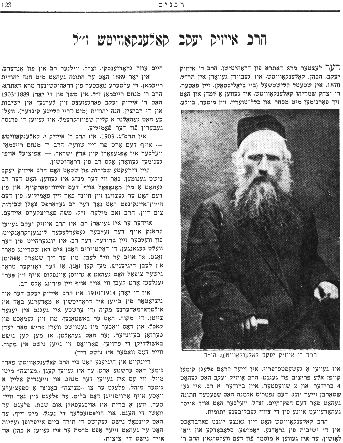
[Page 123]
[Photo:] Rabbi Isaac Yaakov Kalenkovich
[Page 124]
[Photo:] Seated, from right to left: Rabbi Menachem and Mrs. Riva Mindel Reichman, Yosef and Sheina Golda Kalenkovich (grandchildren). Standing, from right to left: Rabbi Zvi Eliyahu Reichman, Mrs. Chana Yehudit Kalenkovich, Devorah and Rabbi Reuven Reichman, the children of Rabbi Menachem.
His two traditional yearly speeches (on the Sabbath before Yom Kippur and the Sabbath before Passover, as was customary in those days) were timely and consistent, and he dealt with local issues. He also never reported anyone to the gentile authorities, and never instructed women to wear wigs, or men to wear tsitsit, etc., because he believed his role as rabbi was to lead in community-wide issues.
During the critical years of World War I, he organized citywide committees to assist the poor and needy. He led a struggle against the distillers who used wheat, rye and potatoes to make schnapps at a time when people were suffering from hunger.
After World War I, Rabbi Isaac Yaakov dedicated all his energy to rebuild the ruined and burned down Drohitchin. With the aid of money from former residents of Drohitchin in the United States, a large synagogue was built on the site of the burned Old House of Study, as were a large religious school, public bath and workshop.
Thanks to his dedication to community issues, the rabbi established many good friendships. His house always a center where people could share their joys and sorrows with him. (A merchant who had a good business approached the rabbi and told him the details about his successful business. Another businessman came to ask the rabbi's advice on how to get out of a bad business arrangement).
The rabbi had a good business sense, which he inherited from his mother. He always gave good business advice. His devoted friends and visitors respected him greatly, and were generous with financial contributions they gave him. This was especially true after a fire broke out twice at his house in a brief period, and his friends and supporters from Drohitchin in the United States made sure to provide him the means to build him a new house worthy of his stature.
In 1928, Chana Yehudit died after a brief illness. She was 58 years old. The death of his wife was a major blow to Rabbi Kalenkovich. In addition to having been a devoted wife and mother of her children, she was the family provider. Many years later, Rabbi Isaac Yaakov remarried. His new wife was a highly respected woman from Baranovich named Mrs. Michela Chafetz. She bore him a daughter named Beila.
As soon as Rabbi Isaac Yaakov took over the rabbinical position from his father-in-law, R. Menachem. None of Rabbi Isaac Yaakov's sons entered the rabbinate, and the
JewishGen, Inc. makes no representations regarding the accuracy of
the translation. The reader may wish to refer to the original material
for verification.
JewishGen is not responsible for inaccuracies or omissions in the original work and cannot rewrite or edit the text to correct inaccuracies and/or omissions.
Our mission is to produce a translation of the original work and we cannot verify the accuracy of statements or alter facts cited.
 Drogichin, Belarus
Drogichin, Belarus
 Yizkor Book Project
Yizkor Book Project
 JewishGen Home Page
JewishGen Home Page
Copyright © 1999-2025 by JewishGen, Inc.
Updated 10 Dec 2001 by LA